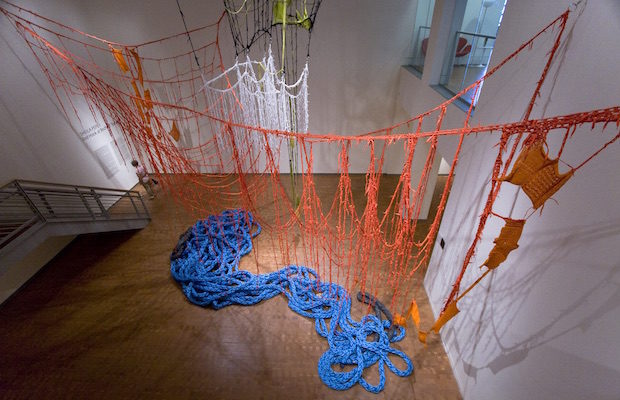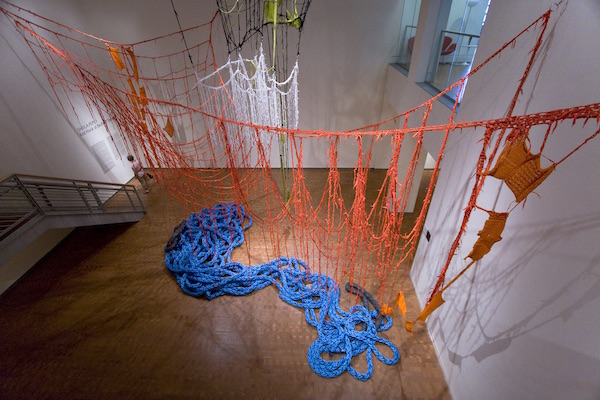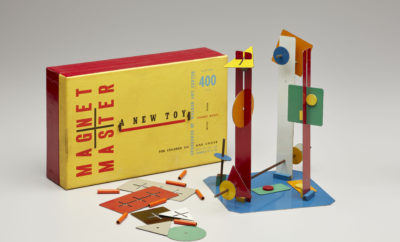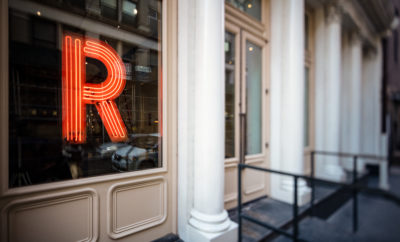 Smith College Museum of Art
Smith College Museum of Art
Exhibition
Untangling Sheila Pepe
ARTIST SHEILA PEPE GREW UP working at Frank’s Deli, her parents’ storefront in Morristown, New Jersey. There, every Wednesday, her mother would make five hundred meatballs and a huge pot of “gravy“—also known as meat sauce to those who didn’t grow up with southern Italian roots. The food of home was made bit-by-bit for others, lovingly, repeatedly. It would disappear to be made again. Today, Pepe is best known for her sweeping, ephemeral crocheted installations made stitch-by-stitch for others, lovingly, repeatedly. They disappear to be made again. “Everything is tangled with resistance and assimilation,” Pepe says of her work. “I’m interested in breaking and reanimating the cultures that I inherit with my own personal experience.”
Pepe’s work caught the eye of Gilbert Vicario, curator of Sheila Pepe: Hot Mess Formalism, opening at the Phoenix Art Museum on October 14, more than fifteen years ago. He first saw her work in the Boston home of art collector Kenneth L. Freed, including two cobweb-like pieces made from fiber and shadow. Like little site-specific secrets, one was tucked into a ceiling soffit, the other was hidden in a closet. “The idea of the spider coming in and making a house wherever she wants,” Pepe explains.
More than a decade later, Vicario would work with the Brooklyn-based artist to stage Put Me Down Gently at the Des Moines Art Center, its third installation as part of the landmark exhibition Fiber: Sculpture 1960–Present, which originated at the Institute of Contemporary Art in Boston, curated by Jenelle Porter. In Des Moines, the installation’s immersive drapes and pools of yarn, parachute cord, and laces set within the bright white geometry of the Richard Meier-designed atrium, led both art and architecture into new contexts. It was then, Vicario says, “I realized that among Pepe’s generation of artists, she hadn’t had a proper museum show.” As such, Pepe’s first mid-career museum survey is among Vicario’s first major exhibitions since joining the Phoenix Art Museum in 2015 as the Selig Family Chief Curator.

Sheila Pepe, Red Hook at Bedford Terrace, 2008. Shoelaces, cotton yarn, and nautical towline. Variable dimensions. Installation view at Smith College Museum of Art. Smith College Museum of Art, purchased with gifts from members of the museum’s visiting committee in honor of the retirement of Ann Johnson.
Pepe’s work is handmade, her materials are readymade—“because I’m a child of Duchamp,” she says—and her suppliers are a global village of owner-operated purveyors. “It’s like my dad calling the butcher,” the artist explains of her personal connection to her sources. Pepe came of age—and came out as gay—in the 1980s, when, “there were still questions about where anybody fit,” she says. “So I always need to know how things are put together. I think that’s partly why my materials are so simple. You can travel through this process that’s exposed to you.”
Among the twists and turns of Pepe’s work, you’ll also find her history—allusions to her grandmother’s crocheted lace, and, in her use of shoelaces, a gesture to her grandfather, who was a cobbler. Each element leads to the next until it becomes one all-encompassing thing, wrapped up with, and pushing against, the space it inhabits.
Architecture is Pepe’s silent collaborator, and in Phoenix this will be rich territory. The museum’s nearly fifty foot–high, skylit gallery, designed by architects Tod Williams and Billie Tsien, will serve as her canvas for a new installation. “It’s a whole new approach,” says curator Vicario of using the museum’s spaces in this way. Hot Mess Formalism (on view to January 28, 2018) will also offer Pepe’s parallel practices in drawing, tabletop sculpture, and video—the artist’s many sides displayed in all of their wonderful, messy complexity. phxart.org












